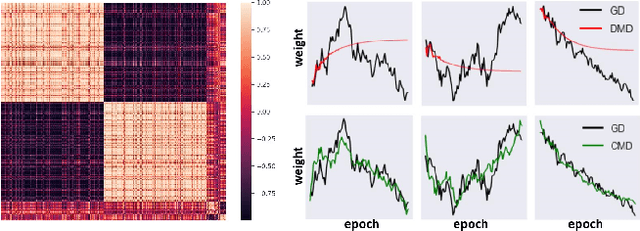Tom Berkov
Enhancing Neural Training via a Correlated Dynamics Model
Dec 20, 2023



Abstract:As neural networks grow in scale, their training becomes both computationally demanding and rich in dynamics. Amidst the flourishing interest in these training dynamics, we present a novel observation: Parameters during training exhibit intrinsic correlations over time. Capitalizing on this, we introduce Correlation Mode Decomposition (CMD). This algorithm clusters the parameter space into groups, termed modes, that display synchronized behavior across epochs. This enables CMD to efficiently represent the training dynamics of complex networks, like ResNets and Transformers, using only a few modes. Moreover, test set generalization is enhanced. We introduce an efficient CMD variant, designed to run concurrently with training. Our experiments indicate that CMD surpasses the state-of-the-art method for compactly modeled dynamics on image classification. Our modeling can improve training efficiency and lower communication overhead, as shown by our preliminary experiments in the context of federated learning.
The Underlying Correlated Dynamics in Neural Training
Dec 18, 2022



Abstract:Training of neural networks is a computationally intensive task. The significance of understanding and modeling the training dynamics is growing as increasingly larger networks are being trained. We propose in this work a model based on the correlation of the parameters' dynamics, which dramatically reduces the dimensionality. We refer to our algorithm as \emph{correlation mode decomposition} (CMD). It splits the parameter space into groups of parameters (modes) which behave in a highly correlated manner through the epochs. We achieve a remarkable dimensionality reduction with this approach, where networks like ResNet-18, transformers and GANs, containing millions of parameters, can be modeled well using just a few modes. We observe each typical time profile of a mode is spread throughout the network in all layers. Moreover, our model induces regularization which yields better generalization capacity on the test set. This representation enhances the understanding of the underlying training dynamics and can pave the way for designing better acceleration techniques.
 Add to Chrome
Add to Chrome Add to Firefox
Add to Firefox Add to Edge
Add to Edge